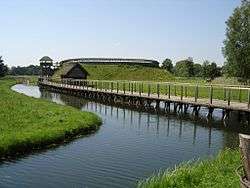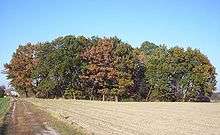Gord (archaeology)
A gord is a medieval Slavic fortified wooden settlement, sometimes known as a burgwall after the German term for such sites. Gords were built during the late Bronze and early Iron Ages by the Lusatian culture (c. 1300–500 BCE), and up to the 7th–8th centuries CE and beyond by other cultures, in what is now Poland, the Czech Republic, Hungary, Slovakia, eastern Germany, Romania, Moldova, Belarus, Serbia, Croatia, Bosnia and western Ukraine. These settlements were usually founded on strategic sites such as hills, riverbanks, lake islands, or peninsulas.


Construction and evolution
A typical gord was a group of wooden houses built either in rows or in circles, surrounded by one or more rings of walls made of earth and wood, a palisade, and/or moats. Some gords were ring-shaped, with a round, oval, or occasionally polygonal fence or wall surrounding a hollow. Others, built on a natural hill or a man-made mound, were cone-shaped. Those with a natural defense on one side, such as a river or lake, were usually horseshoe-shaped. Most gords were built in densely populated areas on sites that offered particular natural advantages.
As Slavic tribes united to form states, gords were also built for defensive purposes in less-populated border areas. Gords in which rulers resided or that lay on trade routes quickly expanded. Near the gord, or below it in elevation, there formed small communities of servants, merchants, artisans, and others who served the higher-ranked inhabitants of the gord. Each such community was known as a suburbium (Polish: podgrodzie). Its residents could shelter within the walls of the gord in the event of danger. Eventually the suburbium acquired its own fence or wall. In the High Middle Ages, the gord usually evolved into a castle or citadel (kremlin) and the suburbium into a town.
Some gords did not stand the test of time and were abandoned or destroyed, gradually turning into more or less discernible mounds or rings of earth (Russian gorodische, Polish grodzisko, Ukrainian horodyshche, Slovak hradisko, Czech hradiště, and Serbian gradiška/градишка). Notable archeological sites include Biskupin, Poland; and Bilsk, Ukraine (see Gelonus).
Etymology
The term ultimately descends from the reconstructed Proto-Indo-European (PIE) root ǵʰortós, enclosure. From this same root come the Germanic word elements *gard and *gart (as in Stuttgart), and likely also the names of Graz, Austria and Gartz, Germany. Cognate to these are English words such as yard, garth, girdle, and court.[1][2] Also cognate but less closely related are Latin hortus, a garden, and its English descendants horticulture and orchard. In the Hungarian language, kert, the word for a garden, literally means encircled. Because Hungarian is a Uralic rather than an Indo-European language, this is likely a loanword.
Further afield, in ancient Iran, a fortified wooden settlement was called a gerd, or certa, which also means garden (as in the suffix -certa in the names of various ancient Iranian cities; e.g., Hunoracerta). The Persian word evolved into jerd under later Arab influence. Burugerd or Borujerd is a city in the west of Iran. The Indian suffix -garh, meaning a fort in Hindi, Sanskrit, and other Indo-Iranian languages, appears in many Indian place names.[3] Given that both Slavic and Indo-Iranian are sub-branches of Indo-European and that there are numerous similarities between Russian and Sanskrit vocabulary, it is plausible that garh and gorod are related. However, this is strongly contradicted by the phoneme /g/ in Indo-Iranian, which cannot be a reflex of the Indo-European palatovelar /*ǵ/.[4]
The Proto-Slavic word *gordъ later differentiated into grad (Cyrillic: град) and gorod (Cyrillic: город), etc.[5][6][7] It is the root of various words in modern Slavic languages pertaining to fences and fenced-in areas (Belarusian гарадзіць, Ukrainian horodyty, Czech ohradit, Russian ogradit, Serbo-Croatian ograditi, and Polish ogradzać, grodzić, to fence off). It also has evolved into words for a garden:
- Belarusian гарод (harod)
- Ukrainian город (horod)
- Russian огород (ogorod)
- Serbian, Bulgarian, and Macedonian градина (gradina)
- Serbian oграда/ograda
- Polish ogród
- Slovak záhrada
- Czech zahrada
Additionally, it has furnished numerous modern Slavic words for a city or town:
- Belarusian горад (horad)
- Russian город (gorod)
- Polish gród
- Ancient Pomeranian and modern Kashubian gard
- Bulgarian, Croatian, Macedonian, and Serbian град(grad)
- Slovak and Czech hrad or Slovene "grad" (castle in modern Slovene)
The names of many Central and Eastern European cities harken back to their pasts as gords. Some of them are in countries which once were but no longer are mainly inhabited by Slavic-speaking peoples. Examples include:
- Horodok
- Gorod (toponymy)
- Hrod (toponymy)
- Harad
- Hrud (toponymy)
- Horod (toponymy)
- Hrad (toponymy)
- Gard (toponymy)
- Grod (toponymy)
- Grad (toponymy)
The words in Polish and Slovak for suburbium, podgrodzie and podhradie correspondingly, literally mean a settlement beneath a gord: the gród/hrad' was frequently built at the top of a hill, and the podgrodzie/podhradie at its foot. (The Slavic prefix pod-, meaning "under/below" and descending from the Proto-Indo-European root pṓds, meaning foot, being equivalent to Latin sub-). The word survives in the names of several villages (Podgrodzie, Subcarpathian Voivodeship) and town districts (e.g., that of Olsztyn), as well as in the names of the German municipalities Puttgarden, Wagria and Putgarten, Rügen.
Important gords in Europe
Germany
Rügen
- the fort at Cape Arkona – the Jaromarsburg
- Garz Castle
- the fort of Charenza near Venz in the municipality of Trent
- the Herthaburg near the Stubbenkammer in the Jasmund National Park
Rest of Mecklenburg-Western Pomerania
- Mecklenburg Castle in the village of Dorf Mecklenburg near Wismar (origin of the state name)
- the fort of Groß Raden near Sternberg
- the fort of Behren-Lübchin, partly reconstructed in the Groß Raden Archaeological Open Air Museum
- Gädebehn Castle (Gemeinde Knorrendorf) in the county of Mecklenburgische Seenplatte
- Ganschendorf Castle (Gemeinde Sarow) in the county of Mecklenburgische Seenplatte
- the fort of Grapenwerder (Gemeinde Penzlin) in the county of Mecklenburgische Seenplatte
- Quadenschönfeld Castle in the county of Mecklenburgische Seenplatte
- Neu Nieköhr Castle (Gemeinde Behren-Lübchin) in the county of Rostock
- the fort of Neu-Kentzlin (Gemeinde Kentzlin) between Demmin und Stavenhagen
- Mölln Castle (Gemeinde Mölln (Mecklenburg)) in the county of Mecklenburgische Seenplatte
- Möllenhagen Castle (Gemeinde Möllenhagen) in the county of Mecklenburgische Seenplatte
- the Ravensburg (Neubrandenburg)
- the forts at Kastorfer See near Neubrandenburg
- the island fort in the Teterower See
- the Schlossberg near Feldberg
- the Slavic fort near Menkendorf, a village in the parish of Grebs-Niendorf
- Wittenborn Castle ( municipality of Galenbeck) in the county of Mecklenburgische Seenplatte
- Kieve Castle in the county of Mecklenburgische Seenplatte
- Wulfsahl Castle in the county of Ludwigslust-Parchim
Berlin-Brandenburg
- Brandenburg Castle
- Spandau Castle (Berlin)
- the Römerschanze near Potsdam
- the Reitweiner Wallberge, fortanlage near Reitwein in the Landkreis Märkisch-Oderland
- the Slavic fort of Lübben
- the Slavic fort of Raddusch near Vetschau/Spreewald
- the Slavic fort of Tornow
- Lossow Castle, Frankfurt (Oder)
- the fort near Kliestow
Saxony-Anhalt
- the fort of Altes Dorf in the Magdeburg subdistrict of Pechau
- Wust Castle
Schleswig-Holstein
- List of Early Middle Ages castles in Hamburg und Schleswig-Holstein including:
- the fort of the Slavic settlement of Starigard in present-day Oldenburg – Oldenburger Wall
Bavaria
- Rauher Kulm
Czech Republic
- Bílina
- Budeč
- Chotěbuz
- Kouřim
- Levý Hradec
- Libice nad Cidlinou
- Libušín
- Mikulčice
- Prague Castle
- Rubín
- Stará Boleslav
- Staré Zámky
- Tetín
- Vyšehrad (Prague)
Poland
See also
- Oppidum, a type of similar but often much bigger fortified wooden settlement used by ancient Celts and Germanics.
- Gordoservon in Asia Minor, 680 AD
- Some cities in India – Chandigarh, Aligarh, Ramgarh (district).
- Garðaríki – Varangian name for Kievan Rus, interpreted as "cities"
- Biskupin, a life-size reconstruction of a gord-like Lusatian settlement in Poland.
- Fortified settlements in other cultures:
- Kraal (South Africa);
- Motte-and-bailey (western Europe).
- Burgh, Borough, Burg or bjerg (Scotland, England, Germany, Denmark)
References
- ON. garðr; goth. gards; den. -gaard; island. -gard; cimb. -garthur; aleman. -gardo; welsh. -gardd; holln. -gaerde; span. -gardin; pomern. -gard; slav. -grod, -hrad
- A Concise Etymological Dictionary of the English Language. Oxford. 1911; Jane Chance. Tolkien and the invention of myth. . 70
- "Urban vocabulary in Northern India – City Words WP No. 4". www.unesco.org. Retrieved 2016-05-09.
- "Sanskrit and Russian: Ancient kinship". in.rbth.com. Retrieved 2016-05-09.
- Taylor, Isaac (1898). Names and Their Histories: A Handbook of Historical Geography and Topographical Nomenclature. Original from the University of Michigan: Rivingtons. p. 331.
wall Grad gorod.
- Taylor, Isaac (1864). Words and Places, Or, Etymological Illustrations of History, Ethnology, and Geography. Original from Oxford University: Macmillan. p. 128.
wall Grad gorod.
- Anthropologische Gesellschaft in Wien (1880). Mittheilungen der anthropologischen Gesellschaft in Wien. Original from the University of Michigan: F. Berger & Söhne. p. 40.
Gord wall Grad gorod.
External links
- Reconstruction of a gród at Grzybowo, Poland – images of a typical ancient Slavic settlement with suburbium, earth-and-wood wall and moat; by Tomek Birezowski (Polish text).